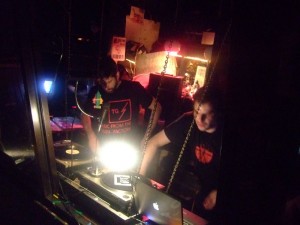The Archaeology of Vinyl
by Heather Pringle
January 23, 2009

Over the recent Christmas season, my 21-year-old deejay nephew flipped through the large collection of vinyl LPs from the sixties, seventies, and eighties now shelved in our basement. Many is the time when I have privately cursed that collection, hauling heavy boxes of vinyl up and down steep flights of stairs on moving days. But my husband steadfastly refused to sell or pitch out anything—from the Dukes of Stratosphear to the Stranglers—and now I’m rather glad that he did. We now have a miniature museum of sound from the sixties, seventies, and eighties, complete with original shrink wraps and a few Andy Warhol covers.
But what will future generations – particularly future archaeologists—make of the hundreds of thousands of tons of vinyl recordings that our civilization pressed in the twentieth and twenty-first centuries? I expect most of you have seen that clever Pepsi commercial set in the future, where a middle-aged archaeologist leads his Pepsi-drinking students through a split level ranch house as if it were a Roman villa, and is unable to identify a dusty glass bottle of Coca-Cola. What will future researchers make of our record collections?
Well now we have a very good idea, thanks to Ofer Springer, an Israeli algorithms engineer. To fritter away some free time, Springer decided to analyze an old vinyl recording of Vivaldi’s “The Four Seasons,†the way a future archaeologist might. He first pored over the platter carefully,  examining it through a magnifying glass and taking note of waveformlike shapes in the record grooves. He then turned to oral history for clues, and recalled a legend that spoke “of a diamond needle that would vibrate when placed atop the revolving flat things,†and how “these vibrations, when amplified, would produce music.â€
So Springer decided to create a digital needle and virtual turntable to play the LP. He first obtained a high-resolution image of the LP on a flatbed scanner. Then he wrote a piece of software to trace the image of the groove and produce sounds based on the wavelike patterns encoded there. Here is what he ended up with. Now take a listen to the original Vivaldi recording.
I found this exercise fascinating for a number of reasons. I think it attests the ingenuity of researchers who will not be stymied completely in the distant future when they stumble across the sherd of a Coca-Cola bottle or a fragment of old vinyl or other detritus from our disposable twentieth-first century culture. They will find clever new ways to decode them. But I think it is also an archaeological lesson in humility. Struggle daily as we do, we can never completely recover the reality of the distant past. It is always just there beyond us–in the deep grooves of an LP or the lost inscriptions of a Roman city.
This entry was posted by Heather Pringle on
Friday, January 23, 2009.
Discussion of this blog entry is now closed.
Comments posted here do not represent the views or policies of the Archaeological Institute of America.

